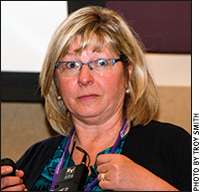ISBCW 2016:
Compromised Cows
Benchmark study looks at magnitude of cull-cow disposal issues.
by Kasey Brown, senior associate editor
MANHATTAN, Kan. (June 10, 2016) — The beef industry is in the market to sell cattle, but what happens to old or injured cows? Treatment of cull cows can help or hurt the industry simply by how it impacts consumer confidence.

Karen Schwartzkopf-Genswein, researcher at the Lethbridge Research and Development Centre for Agriculture and Agri-Food Canada, shared her ongoing research on the incidence, characterization and disposal of compromised cattle arriving at auctions and processing plants.
There is very little research done on compromised cows, so Karen Schwartzkopf-Genswein, researcher at the Lethbridge Research and Development Centre for Agriculture and Agri-Food Canada, shared her ongoing research on the incidence, characterization and disposal of compromised cattle arriving at auctions and processing plants. She spoke to attendees of the fifth International Symposium on Beef Cattle Welfare in Manhattan, Kan., June 8-10.
She noted the difference between compromised and unfit cattle for transport, admitting that most still have to look up the requirements when a questionable case comes up. According to the Canadian Food Inspection Agency’s Compromised Animal Policy, compromised cattle have a reduced capacity to withstand transport, but with a special provision: they can be transported without undue suffering. This includes local transport to receive care, be euthanized or humanely slaughtered. Unfit cattle have a reduced capacity to withstand transport with a high risk, so that transport would lead to undue suffering. This includes local transport for veterinary treatment and diagnosis.
Examples of cattle that cannot be transported, and are therefore labeled as unfit, include those unable to stand or move without assistance; emaciated, dehydrated or exhausted; having a rupture of pre-pubic tendon or a fractured limb or pelvis; in shock or dying; suspected or confirmed of having a nervous system disorder; having a fever; likely to give birth; less than 48 hours of age; or exhibiting severe lameness.
All too often, Schwartzkopf-Genswein said, she’s heard, “I shipped her because …” with a variety of excuses like she looked fine when she went on the trailer, she wasn’t that bad, she was still worth money and more.
She explained that her research team is looking to assess the number of cattle arriving at auctions and processing plants in a compromised condition, and characterize which conditions are most prevalent. They also want to document the relationship between compromised cattle and age, and catalogue the disposal of compromised cattle. Additionally, she said, they want to find out the magnitude of compromised cattle.
She shared 2015 slaughter data vs. a pilot data in 2016. The incidence of lameness increased from 5% in 2015 to 23% in 2016; injuries went from 5% in 2015 to 10% in 2016; and body condition score of 3 or less and/or weakness went from 10% in 2015 to 8% in 2016.
They sampled large and small auction markets; and large, medium and small processing plants, with a host of data collection methods. They looked at arrival conditions, risk factors and disposal methods. Research is ongoing, but she said they hope to characterize the incidence and type of compromise at different collection points to see the magnitude of the problem. Is there an association with potential risk factors like age, breed or distance travelled? They also want to ID the fate of compromised animals and improve assessment and tracking of compromised cattle.
Watch for additional coverage of the 2016 ISBCW on www.angus.media and in the Angus Journal and Angus Beef Bulletin. Comprehensive meeting coverage will be archived www.api-virtuallibrary.com/meetings_other_news.html.
Editor’s Note: The articles
used within this site represent a mixture of copyrights. If you would
like to reprint or repost an article, you must first request permission
of Angus Media by contacting the editor at 816-383-5200; 3201 Frederick Ave., Saint Joseph, MO 64506. Angus Media
claims copyright to this we site as presented. We welcome educational
venues and cattlemen to link to this site as a service to their
audience.






